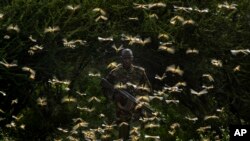The U.N.’s Food and Agriculture Organization says a small group of desert locusts has entered Congo, marking the first time the voracious insects have been seen in the Central African country since 1944.
The agency says the mature locusts, carried in part by the wind, arrived on the western shore of Lake Albert on Friday near the town of Bunia.
The worst locust outbreak that parts of East Africa have seen in 70 years also recently reached South Sudan, a country where roughly half the population already faces hunger after years of civil war.
Kenya, Somalia and Uganda also have been battling the locust swarms, which can reach the size of major cities.
The insects can destroy crops and devastate pasture for animals, and experts have warned that the outbreak is affecting millions of already vulnerable people across the region.
Uganda’s government said Tuesday it was trying to contain a large swarm and will need more resources to control the infestation that has spread to over 20 districts in the north. Soldiers have been battling swarms using hand-held spray pumps, while experts have said aerial spraying is the only effective control.
The U.N. recently raised its aid appeal from $76 million to $138 million, saying the need for more help is urgent. Experts have warned that the number of locusts if unchecked could grow 500 times by June, when drier weather is expected in the region.
A changing climate has contributed to this outbreak as a warming Indian Ocean means more powerful tropical cyclones hitting the region. A cyclone late last year in Somalia brought heavy rains that fed fresh vegetation to fuel the locusts that were carried in by the wind from the Arabian Peninsula.
A new generation of the locusts has been growing up in the Somalia desert in recent weeks, preparing to take flight as the next wave headed toward Kenya, Ethiopia and beyond.







